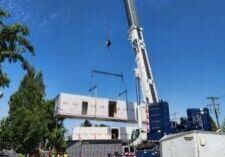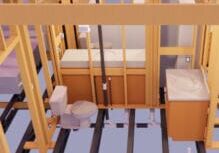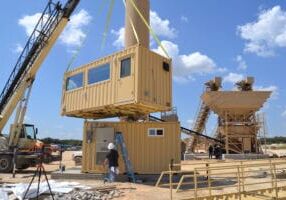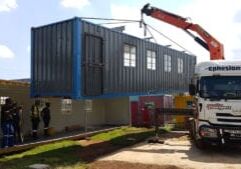Inflation Comes in Hot to Begin '24

Anirban Basu is the Chairman & CEO of Sage Policy Group and Chief Economist of the Modular Building Institute.
Last year was a shockingly good one for the U.S. economy, at least relative to expectations. Coming into 2023, the conventional wisdom was that near-term recession was inevitable in America. In the face of belligerent excess inflation (above the Federal Reserve’s 2 percent mandate), monetary policymakers began ratcheting interest rates higher in March 2022. That process continued throughout the balance of the year and into 2023. At least partially as a result, equity markets sustained large losses in 2022 as corporate borrowing costs soared.
All of this was viewed as precursors to a broader economic downturn. The high-powered economists at Bloomberg maintain a forecasting index that suggested that the probability of recession in America as of October 2022 was 100 percent.
Instead, America had a fine year economically even as Europe flirted with recession, Japan entered one, and as China languished. During 2023’s initial quarter, the U.S. economy expanded 2.2 percent on an annualized basis. The following quarter, growth ticked lower to 2.1 percent, suggesting to some that perhaps a recession was forthcoming during the back half of the year. Instead, the economy rallied, expanding at an unpredicted 4.9 percent during the third quarter and 3.4 percent during the fourth. For the year, the economy expanded 2.5 percent. If one compares the fourth quarter of 2022 to 2023’s fourth quarter, output grew an even more impressive 3.1 percent.

Anirban Basu speaks at the Modular Building Institute's annual World of Modular conference.
The outperformance of the economy coupled with breathless anticipation of Federal Reserve rate cuts pushed equity prices higher last year. The tech-laden Nasdaq expanded an eye-popping 43 percent, while the S&P 500 returned 24 percent and the Dow Jones 13 percent. Rate tightening ended with a quarter point rate increase on July 26th, 2023. Investors have been waiting for the renewal of monetary accommodation ever since. Alas, they may have longer to wait.
In June 2022, as supply chains struggled to normalize and as consumers were amid a spending spree, prices rose with especial rapidity in the context of widespread scarcity. During the one-year period ending June 2022, economy-wide inflation peaked at a 40-year high of 9.1 percent. But as supply chains improved thereafter and direct federal subsidies to households and businesses faded, inflation edged lower. By January 2024, year-over-year inflation was down to 3.1 percent according to the Consumer Price Index (CPI). If one engages in simple extrapolation, the Federal Reserve’s target rate of 2 percent must be right around the corner.
It is never so simple. The January data came in a bit hotter than expected. Many economists had predicted that the year-over-year inflation would have dipped below 3 percent. By March, overall inflation according to the CPI was back to 3.5 percent year-over-year. The core rate of inflation, which excludes food and energy prices, stood at 3.8 percent. Another measure, the core PCE deflator, a measured favored by Federal Reserve policymakers, was up 2.8 percent on a year-ago basis in February. In short, achievement of the 2 percent inflation target remains elusive.
Coming into the year, many investors anticipated in the range of six quarter-point rate cuts by the Federal Reserve. The first one was set to occur in March. That meeting has come and gone, and there has been no movement on rates.
In an April CNN article, Greg McBride, the chief financial analyst at Bankrate, said, “You can kiss a June interest rate cut goodbye.” The article also noted that the markets’ probability of a rate cut in June declined from 73 percent in March to just 21 percent as of April 10th, a reflection of the extent to which higher-than-expected inflation has surprised bond and other traders.
There are many implications, including the fact that mortgage rates are no longer declining. The result is that mortgage applications, a leading indicator of home sales, continue to be substantially below the 2021 cyclical peak. Nonetheless, home prices remain elevated since many homeowners have refinanced to ultra-low mortgage rates and choose not to sell the homes to which they are attached presently. Among those who suffer because of such dynamics are realtors (lack of transactional volume) and title agents (ditto).
The obvious question is why inflation is returning. As has been reported in recent months, wage pressures remain abundant; so much so that 2 percent inflation remains unlikely in the near-term. As of February, there were 8.8 million available, unfilled jobs in America. In March, the nation’s rate of unemployment fell to 3.8 percent. With so many job openings and so few people to fill them, wage pressures remain firmly in place.
But that is not where the causation story ends. A sea of newly emerging supply chain issues has emerged, including those involving Houthi rebels, Somali pirates, water levels in the Panama Canal, supply chain relocation, including from China to the U.S., Baltimore’s Francis Scott Key Bridge collapse and others. Each of these is conspiring to drive up costs, whether in the form of massive increases in maritime insurance or lengthier distances to travel.
As reported by Reuters (February 7th, London), certain underwriters have raised the premiums they charge to American, British, and Israeli firms by as much as 50 percent for ships transiting the Red Sea. As stated in a Reuters report from earlier this year, “This translates into hundreds of thousands of dollars of additional costs for a seven-day voyage.”
The Baltic Freight Index serves as a barometer for shipping costs by reflecting the price of transporting goods across the world. In 2020 and 2021, the index experienced substantial volatility. During peak recovery, the index rose more than 300 percent during a period of massive growth in the demand for goods and concomitant port congestion and container shortages. Prior to 2020, the average index value was in the range of 1,000, but that figure expanded to more than 4,000 by mid-2021. This is in fact the period during which inflation was at its most rampant, though the Federal Reserve did nothing to increase interest rates that year.
Since 2022, the index has trended downward as supply chains normalized or roughly so. Logistics improved and bottlenecks became less of an issue. By the end of 2023, the index had dipped in value to approximately 2,500. The decline reflected greater supply chain reliability, including the availability of diversified/alternative shipping routes and expanded investment in infrastructure. More recently, events both globally and domestically have restored volatility to the index.
More from Modular Advantage
AI, Faster Sets, and Automation: The Future of Modular is at World of Modular
While the modular building industry has long known that it can be an effective solution to increase affordable housing, the word is slowly spreading to more mainstream audiences. Three presentations at this year’s World of Modular in Las Vegas hope to provide insight and direction for those seeking a real solution to the crisis.
An Insider’s Guide to the 2025 World of Modular
The Modular Building Institute is bringing its global World of Modular (WOM) event back to Las Vegas, and with it comes some of the industry’s best opportunities for networking, business development, and education. Over the course of the conference’s four days, there will be numerous opportunities for attendees to connect, learn, and leverage event resources to get the most out of the conference.
Affordable Housing Now: The Industry’s Best Bring New Solutions to World of Modular
While the modular building industry has long known that it can be an effective solution to increase affordable housing, the word is slowly spreading to more mainstream audiences. Three presentations at this year’s World of Modular in Las Vegas hope to provide insight and direction for those seeking a real solution to the crisis.
Opportunities for Innovation in Modular Offsite Construction
Modular Offsite Construction has already shattered the myth that it only produces uninspired, box-like designs. Architectural innovations in module geometry, configurations, materials, and products make it possible to create visually stunning buildings without sacrificing functionality or efficiency.
Safe Modular Construction with Aerofilm Air Caster Transport
In collaboration with Aerofilm Systems, Heijmans developed innovative skids using air caster technology for moving modules easily and safely. These pallets are equipped with an auto-flow system, making operation extremely simple.
Miles, Modules, and Memes: Building a Modular Network One Flight at a Time
At the end of the day, social media is just another tool for building connections, and like any other tool, needs to be used skillfully to work properly. Use social media thoughtfully, and it will open doors to real opportunities and relationships you didn’t even see coming.
Falcon Structures: Thinking Inside the Box
Some of Falcon’s latest projects include creating container solutions for New York’s Central Park and an East Coast professional baseball team. More and more, Falcon is shipping out container bathrooms and locker rooms to improve traditionally difficult work environments, like those in oil and gas or construction.
UrbanBloc—From Passion to Industry Leader
UrbanBloc specializes in three main categories or markets – what they call “Phase 0” projects, amenities, and urban infill. Clients are often attracted to shipping containers because from a real estate perspective they are considered an asset. Having the flexibility to move and transport these assets allows owners to respond to different circumstances in a fluid manner that they can’t get with standard construction.
The Hospitality Game-Changer
“Hospitality is about more than just providing a service – it’s about delivering an experience,” says Anthony Halsch, CEO of ROXBOX. “And that’s where containers thrive. They allow us to create spaces that are unique, efficient, and sustainable.”
Container Conversions Counts on Simplicity to Provide Critical Solutions
Container Conversions has fabricated and developed thousands of containers for varied projects, including rental refrigeration options, offices, kitchens, temporary workplace housing, and mobile health clinics.










